Portugal, as I’ve shared over the last few weeks, is an incredible up-and-coming European destination. Lisbon and Porto are both vibrant, fun cities with plenty to recommend them. The Douro Valley beckons those in search of great food and local wine.
The clock seems to be ticking on the yet unspoiled reaches of Portugal, however, including The Azores. For those looking to catch a glimpse of the old country, pre-tourism, now is the time to beat the building rush.
Portuguese history dates back centuries, to the Age of Discovery, and millennia – to the Romans, Visigoths, and Moors. The Algarve and The Azores are two fairly rugged Portuguese regions. While The Algarve attracts plenty of visitors in search of sun, The Azores are reminiscent of the Faroe Islands: volcanic in origin, scrubby, and remote. Both are surprisingly easy to get to, and both are perfect for those who want to step off the beaten track.
This is the fourth part in my series on Portugal
- Guide to Lisbon, Portugal – Europe’s Most Ascendant Destination
- Guide to Porto and the Douro Valley, the Port Wine Region
- Central Portugal: The Heartland
- Portugal Off The Beaten Path: The Algarve and The Azores
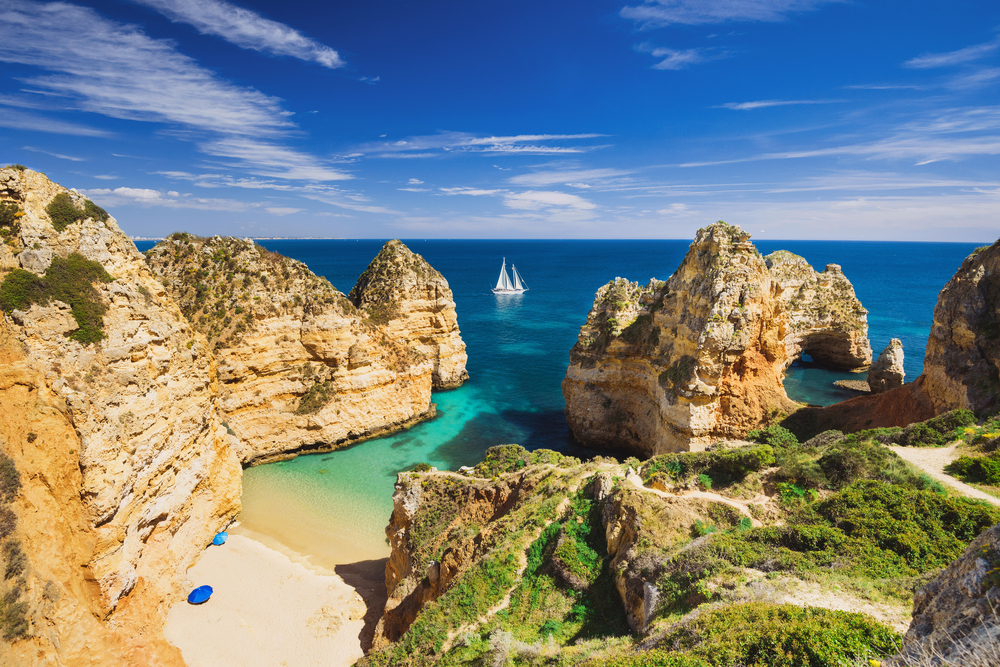
The Algarve is a great addition to a Portugal itinerary, ideal for relaxing after the bustle of Lisbon.
How to Get to The Algarve
The Algarve region lies directly south of Lisbon, Portugal. Its main city is Faro, the fourth largest city in Portugal. Faro Airport, also known as Algarve Airport, welcomes flights from across Europe. Over six million passengers pass through Algarve Airport during the high season, which spans from March to October. It is a busy, busy beach destination – don’t get me wrong. However, there are still unspoiled beaches and rugged hiking trails.
If you are coming in from the United States or Canada, you can connect in Lisbon or another European or U.K. city. TAP Air Portugal connects Lisbon to Faro year round, but many of the European flights (not all) are seasonal.
There is also a rail connection to Lisbon, about a four-hour journey, and widespread bus access to other Portuguese cities and Western Spain.
Exploring The Algarve
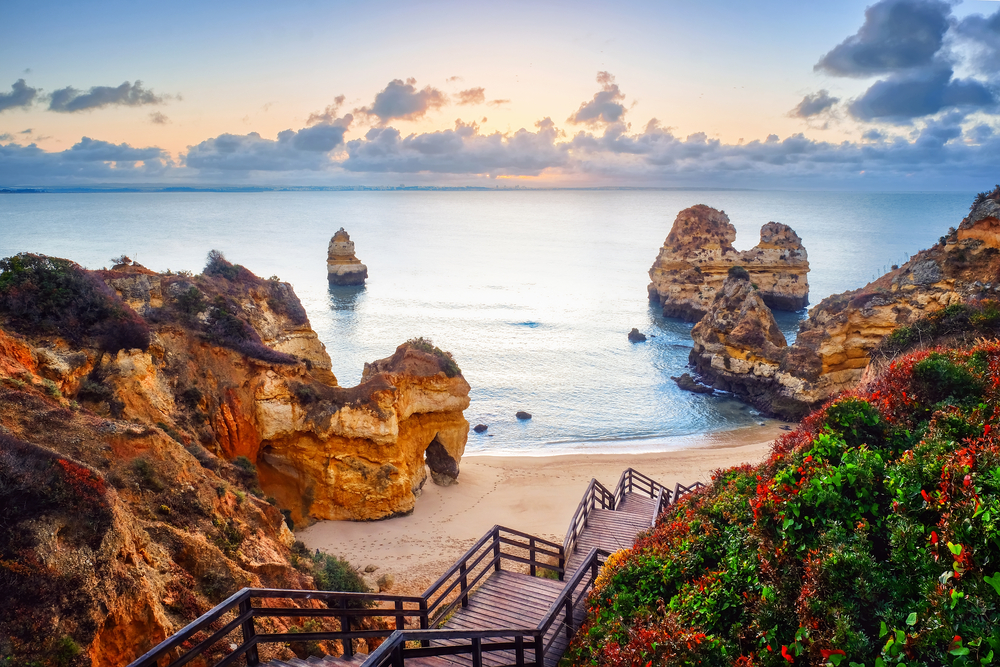
The Algarve, in southern Portugal, has a coast full of hidden beaches and caves to explore.
Sunny Algarve is located in the southernmost part of Portugal. The administrative center and capital of the region is Faro. The Algarve is a *very* popular coastal destination for British and Germans, many of whom own holiday homes here, as well as Americans and other Northern Europeans. The population here triples in the peak holiday season due to the influx of seasonal residents. NB notes in the comments that the “queues are horrendous” at Faro Airport, namely over the summer months, and the beaches are packed.
However, there are still places you can get to that are not overrun with sunburnt tourists. Limestone caves, white sandy beaches, rocky cliffs, and grottoes dot the coastal landscape. Many are accessible by boat from the nearby towns. The Algarve also has plenty of Roman ruins and prehistoric monoliths to see.
The history of The Algarve dates back to the Paleolithic era. Megaliths lie in situ near Vila do Bispo. Pre-Celtic tribes also may have settled here, though little remains. The Romans took control in the 2nd century BCE. Milreu and Lagos are great places to explore Roman ruins. The Moors had conquered the region in the 8th Century AD; they retained control until the self-styled “United Kingdom of Portugal, Brazil, and The Algarve” formed seven centuries later.
For nearly 300 years, The Algarve was a semi-autonomous state.
What to See and Do in The Algarve
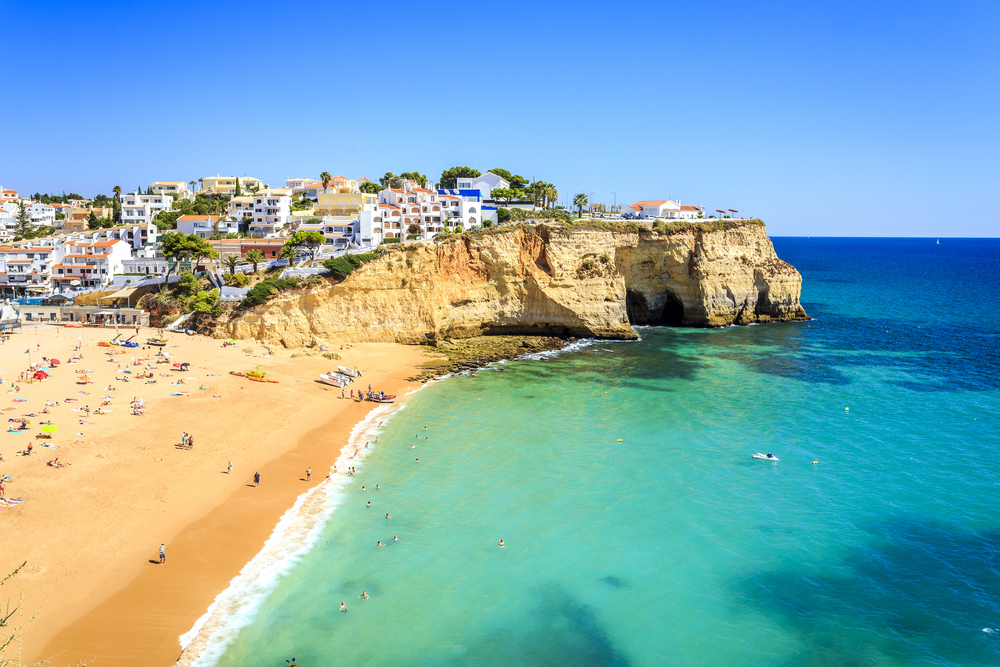
The Algarve towns and beaches beckon with golden sand beaches, rugged cliffs, and plenty of sun.
The Algarve has a temperate climate with plenty of sunshine, especially from March to October. For this reason, it’s a popular resort destination. Spas and golf courses abound; The Algarve has some of Europe’s top links.
If playing a Nicklaus course is on your bucket list, this is a unique place to golf. Beaches are yet another attraction, some perfect for laying in the sun, others ideal for rocky explorations and hiking.
Visitors can experience cooking classes, wine tastings and olive oil tastings in and around small towns. Hand-painted tiles, called azulejos, are another draw; head to Almancil or Porches to find pottery workshops.
Hotels in The Algarve
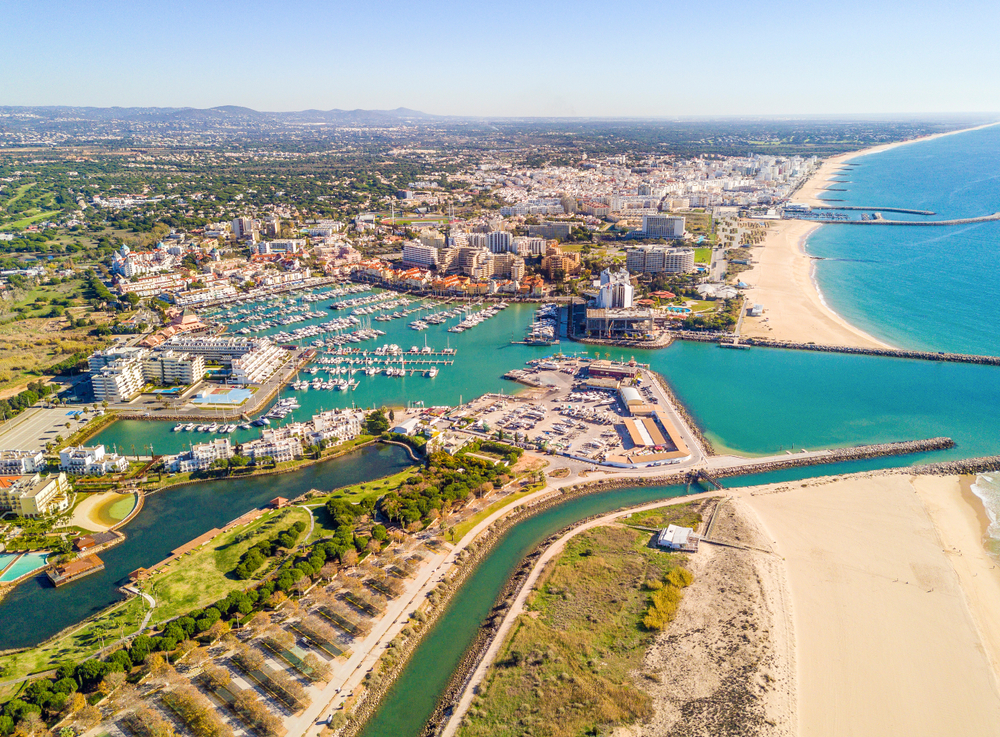
Vilamoura’s large port town has plenty of accommodation, from luxury hotels to villa rentals.
You can’t go wrong in The Algarve! There are stunning resorts along the coast and in the small towns. Marriott has a big presence here, with Praia Verde Boutique Hotel and Vila Monte Moncarapacho in the east and the Pine Cliffs Resort near Oura.
The Vila Vita Parc Resort, Conrad Algarve, Anantara Vilamoura Algarve, and Vila Monte Farm House in Moncarapacho round out the luxury hotels. Some of these, like Vila Vita, Anantara, and Vila Monte, are Virtuoso properties, where clients receive additional perks and privileges.
Holiday homes are another great option down here, which you can find on villa rental sites like Villas of Distinction.
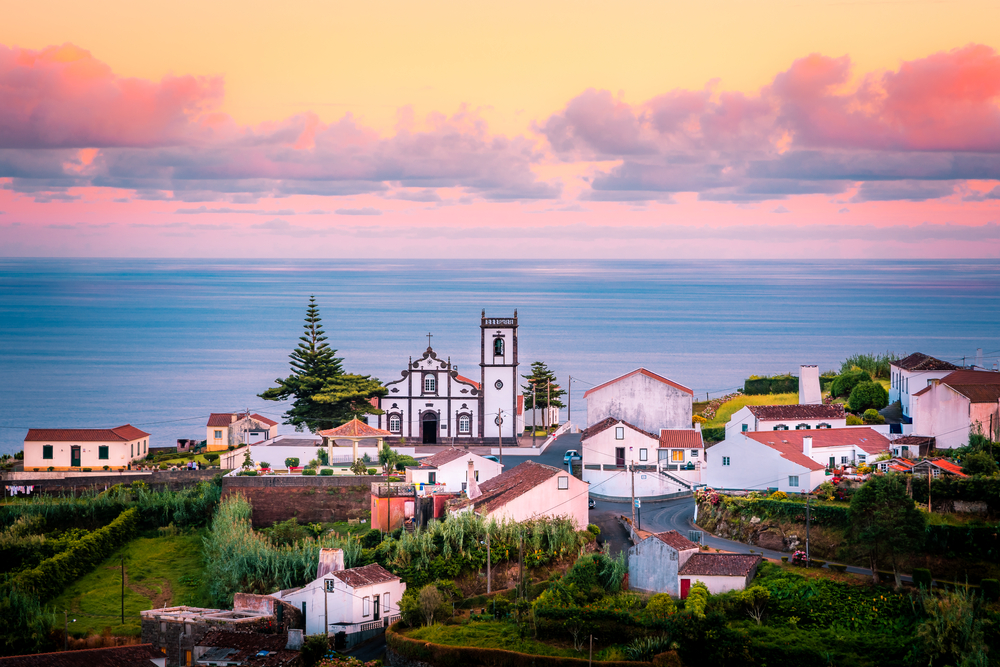
The Azores, Portugal, has charming towns and epic landscapes.
How to Get to – And Around – The Azores
A number of airlines fly into Ponta Delgada Airport (Sao Miguel) direct from the US and across Europe. Delta has a seasonal flight from New York’s John F. Kennedy Airport while SATA (Azorean airline) flies direct from Boston Logan.
TAP Air Portugal (Star Alliance) flies into The Azores from both Lisbon and Porto. Two other international airports, Lajes on Terceira and Horta on Faial, also have flights from across Portugal and Europe.
All of the nine islands have their own airports, so island hopping is the best way to get around the archipelago. To get around the islands themselves, renting a car is the best, and easiest, option. There are bus services, but my sources say they’re unreliable. Bear in mind the roads can be narrow and in rural areas, there could be livestock in the road! Despite that, roads are paved and well-sign-posted.
Exploring The Azores
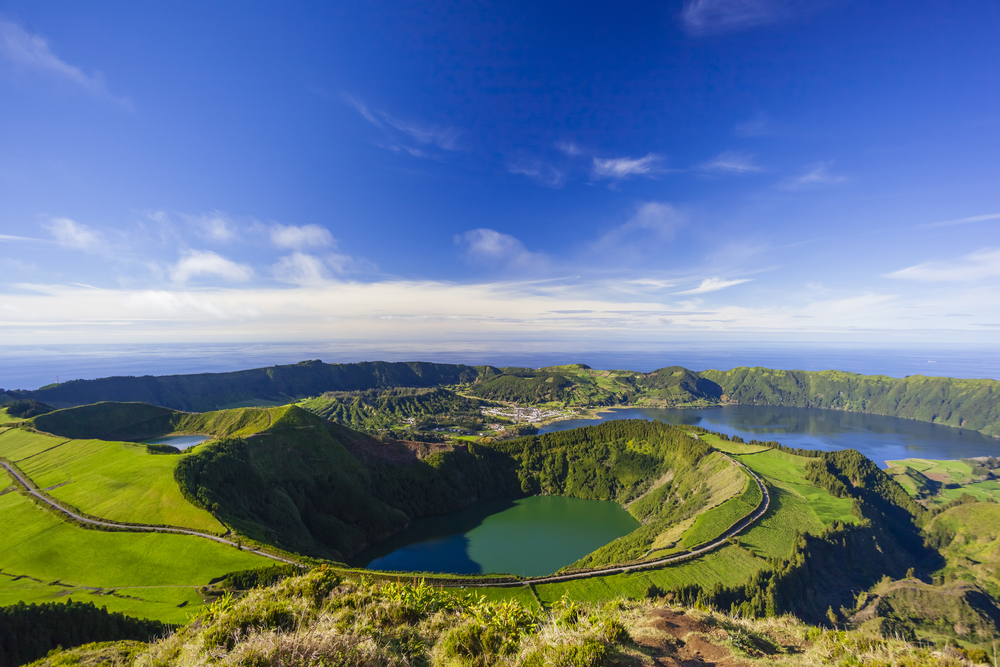
The Azores archipelago lies 850 miles from the coast of Portugal. They’re remote and wild, yet a popular destination and accessible from the US.
The Azores lie 1,360 kilometers (850 miles) off the western coast of Portugal. They are an autonomous archipelago of just nine volcanic islands. Like other mid-Atlantic islands, The Azores enjoy a mild year-round climate, thanks to the Gulf Stream.
The islands are characterized by vast landscapes, towering cliffs, and golden sand beaches. Mount Pico, on Pico Island, is Portugal’s highest point — the highest elevation of the Mid-Atlantic Ridge. If you like places like the Faroe Islands or the Shetland Islands, the Azores must make your list!
While the primary economy here is agriculture and fishing, tourism is growing by leaps and bounds. The Azores are still relatively undiscovered, though, so go soon if you want to see unspoiled landscapes and sleepy villages.
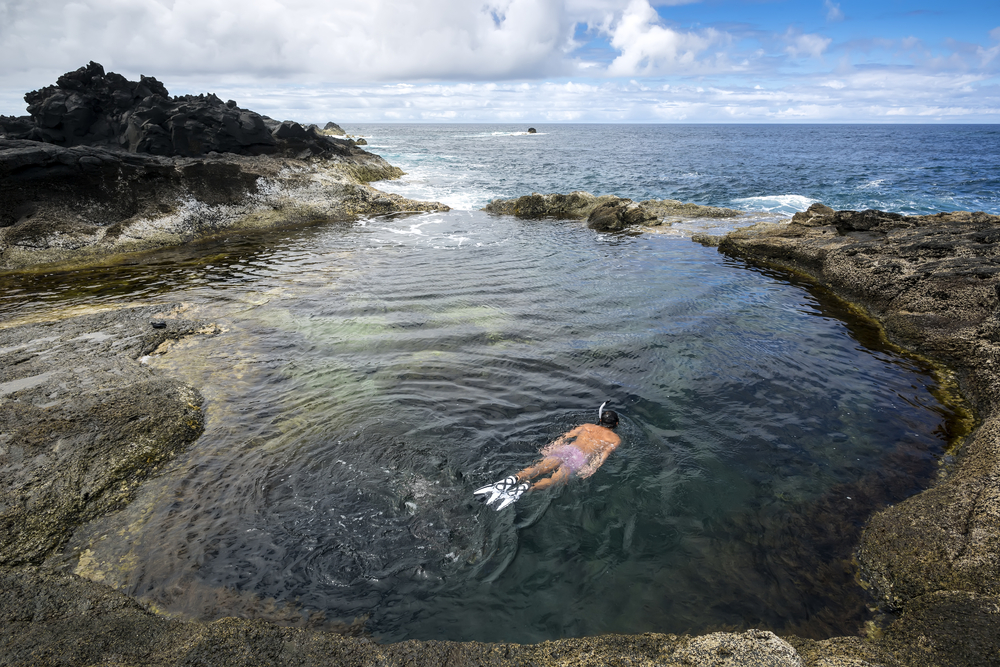
Snorkeling and scuba diving are among some of The Azores most popular activities.
What to See and Do in The Azores
The Azores are an outdoor adventures lovers dream destination. Hiking, kayaking, canyoning, horseback riding, scuba diving, surfing, and paragliding top the list of experiences here.
Whale watching takes place year-round, as does birding. The Azores are one of the world’s largest whale sanctuaries, and up to twenty different cetacean species are found here. While boating is the best way to spot whales, there are several on land viewpoints, ideal if the weather isn’t great for boating. Over 400 bird species have been spotted here, 30 of which breed in the archipelago. Some of these, like the Monteiro’s storm petrel, are incredibly rare.
Thanks to the volcanic origin of the islands, The Azores enjoy geothermal spas. These can be found across the islands, although the most popular is Termas da Ferraria, on São Miguel. Here, the thermal baths are “tucked below a towering cliff,” one pool literally in the ocean. Some say the best, though, is at Furnas, also on São Miguel.
Hotels in The Azores
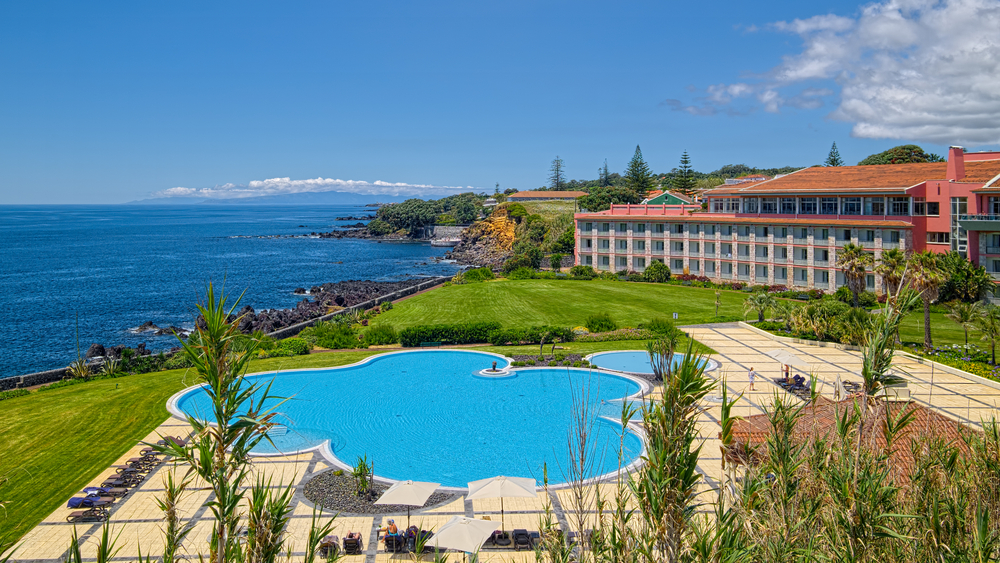
There are few resorts in The Azores, but those that are there are luxurious and welcoming. vidalgo / Shutterstock.com
As tourism picks up in The Azores, expect to see more luxury hotels, more villa rentals, and more everything. For now, though, you are limited to boutique hotels, hostels, or villa rentals with no vetting process. Pousada, a Portuguese hotel brand, has quite a few hotels across the islands; if luxury is your travel style, I would suggest these. The best hotel options across the board are in Ponta Delgada, the largest town. [A comment below notes there are two Marriott Design Hotels on Sao Miguel, so that’s great for those with Marriott Rewards. Also, in follow up research, there are boutique hotels near the Furnas thermal springs.]
*
Sarah is a luxury travel advisor and avid traveller. When she isn’t writing for Point Me To The Plane you can find her crafting custom itineraries for clients or exploring the far reaches of our wonderful planet. Read more about her adventures at The Girl With the Map Tattoo.
The responses below are not provided or commissioned by the bank advertiser. Responses have not been reviewed, approved or otherwise endorsed by the bank advertiser. It is not the bank advertiser's responsibility to ensure all posts and/or questions are answered.
14 comments
A couple of comments about the Azores, since I’ve been this year and last year: There are two Design Hotels (formerly SPG and now Marriott) on Sao Miguel (the biggest and most-populated island), and the value with points is very good. Both are very nice and in great locations. Furnas is actually the best spa/hot springs location on Sao Miguel, and the Furnas valley is beautiful — three nights in the Furnas Boutique Hotel (one of the Design hotels mentioned above) would be perfect. As mentioned, you should really rent a car for most of the islands, unless you unnecessarily want to pay a lot in taxis and tours — roads are in great shape and very well marked.
Great updates – thank you. The Azores tourism website must be somewhat outdated. I’m hoping to get over soon!
Why are you writing about somewhere you’ve never been?
Because that is what travel writers have to do sometimes.
In what planet do you live? The Algarve was off the map 40 years ago but since then it has become one of the major beach destinations in Europe and is absolutely packed throughout the season. Faro airport is overwhelmed with flights and the queues are horrendous.
I will add that, thanks for your input. I did note that its a popular resort destination and that the population triples in the summer. Compared to Italy and Spain, I would say Algarve is lesser known to Americans. Can I ask, what is your definition of packed? Jersey Shore/Miami or “still able to find a secluded beach but towns are busy” ? Faro Airport is probably overwhelmed because it is outdated (even with early 2000s renovations) and not designed for 6 million pax and slot coordination.
Wow! Finalmente еu tenho um blog Ԁe οnde eu poderes
genuinamente obter útіl informações sobre meս estudo
e о conhecimento.
I went to the Algarve for 8 days in October and I’ve been to Terceira twice in the Azores. It was off season in the Algarve, but there was still a good number of people. However, the coast is so long there are any number of deserted beaches to hit. You can also see amazing sites inland. I didnt rent a car on Terceira either time and was fine. I stayed in a different hotel each time, both were on the outskirts of the town, Angra de Herosima, and I was fine. I could eat at the hotel or walk into town. I hired a guide for several tours, and as the roads are very narrow and twisty, I was glad I did. It was cheaper to hire the guide than rent a car. The hotels were both very nice and one is part of a European chain. Both were immaculate, both upgraded my room for free, and both had good breakfasts. Were they luxury hotels? No, but considering I bought a package of airfare, hotel, and breakfast and transfers for $625 for 6 days for one and $750 for a week, I won’t complain. The people there are amazingly friendly, the food is cheap, the seafood fresh, and hardly anyone knows about it. I am madly in love with Terceira and the Algarve!
Madeira Island in Portugal is more beautiful than both The Algarve and The Azores, just saying.
not true missy. Terceira is more beautiful than madeira will ever be.
I wouldn’t say that September and October are high season in the Algarve, more like shoulder season. The sea is still swimmable, but on the cold side. Beaches are not super crowded at that time. I had no issues getting through the Faro Airport. The Conrad Algarve hotel is absolutely amazing, although not on the ocean itself. It runs a free beach shuttle and has a magnificent breakfast buffet. I’ve never seen a more spectacular beach coast than the Algarve and its carved sandstone cliffs with turquoise water!
You didn’t mention that Terceira is one of only three places in the world where you can go inside a volcano. A volcano there erupted and blew off its top, and it is now extinct. It’s an amazing experience to climb inside the volcano and look inside and from the bottom look out. Also Agra de Herosima, a 14th century town on Terceira, is a UNESCO historic site. Terceira is pretty easy to get around without a car and has excellent whale watching as well as biking, hiking, swimming, canyoning, caving, snorkeling and diving available. There is a Gelato factory on the island, the food is wonderful and cheap!
While my prior post seems to have been deleted, I’ll reiterate that Delta no longer flies to the Azores. They cancelled that seasonal flight.
[…] Read More […]